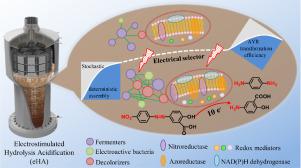Water Research ( IF 12.8 ) Pub Date : 2021-10-08 , DOI: 10.1016/j.watres.2021.117744 Aijie Wang 1 , Ke Shi 2 , Daliang Ning 3 , Haoyi Cheng 1 , Hongcheng Wang 1 , Wenzong Liu 1 , Shuhong Gao 1 , Zhiling Li 2 , Jinglong Han 1 , Bin Liang 1 , Jizhong Zhou 3

|
Electrostimulated hydrolysis acidification (eHA) has been used as an efficient biological pre-treatment of refractory industrial wastewater. However, the effects of electrostimulation on the function and assembly of planktonic anaerobic sludge microbial communities are poorly understood. Using 16S rRNA gene and metagenomic sequencing, we investigated planktonic sludge microbial community structure, composition, function, assembly, and microbial interactions in response to electrostimulation. Compared with a conventional hydrolysis acidification (HA) reactor, the planktonic sludge microbial communities selected by electrostimulation promoted biotransformation of the azo dye Alizarin Yellow R. The taxonomic and functional structure and composition were significantly shifted upon electrostimulation with azo dyes degraders (e.g. Acinetobacter and Dechloromonas) and electroactive bacteria (e.g. Pseudomonas) being enriched. More microbial interactions between fermenters and decolorizing and electroactive bacteria, as well as fewer interactions between different fermenters evolved in the eHA microbial communities. Moreover, the decolorizing bacteria were linked to the higher abundance of genes encoding for azo- and nitro-reductases and redox mediator (e.g. ubiquinone) biosynthesis involved in the transformation of azo dye. Microbial community assembly was more driven by deterministic processes upon electrostimulation. This study offers new insights into the effects of electrostimulation on planktonic sludge microbial community function and assembly, and provides a promising strategy for the manipulation of anaerobic sludge microbiomes in HA engineering systems.
中文翻译:

浮游污泥微生物群落功能和组装的电气选择
电刺激水解酸化 (eHA) 已被用作难处理工业废水的有效生物预处理。然而,电刺激对浮游厌氧污泥微生物群落的功能和组装的影响知之甚少。我们使用 16S rRNA 基因和宏基因组测序,研究了响应电刺激的浮游污泥微生物群落结构、组成、功能、组装和微生物相互作用。与传统的水解酸化 (HA) 反应器相比,通过电刺激选择的浮游污泥微生物群落促进了偶氮染料茜素黄 R 的生物转化。不动杆菌属和脱氯单胞菌属)和电活性细菌(例如假单胞菌属)) 被丰富。在 eHA 微生物群落中,发酵罐与脱色和电活性细菌之间的微生物相互作用更多,而不同发酵罐之间的相互作用更少。此外,脱色细菌与编码偶氮和硝基还原酶以及参与偶氮染料转化的氧化还原介质(例如泛醌)生物合成的基因的丰度更高有关。微生物群落组装更多地由电刺激时的确定性过程驱动。这项研究为电刺激对浮游污泥微生物群落功能和组装的影响提供了新的见解,并为在 HA 工程系统中操纵厌氧污泥微生物组提供了有前景的策略。



























 京公网安备 11010802027423号
京公网安备 11010802027423号